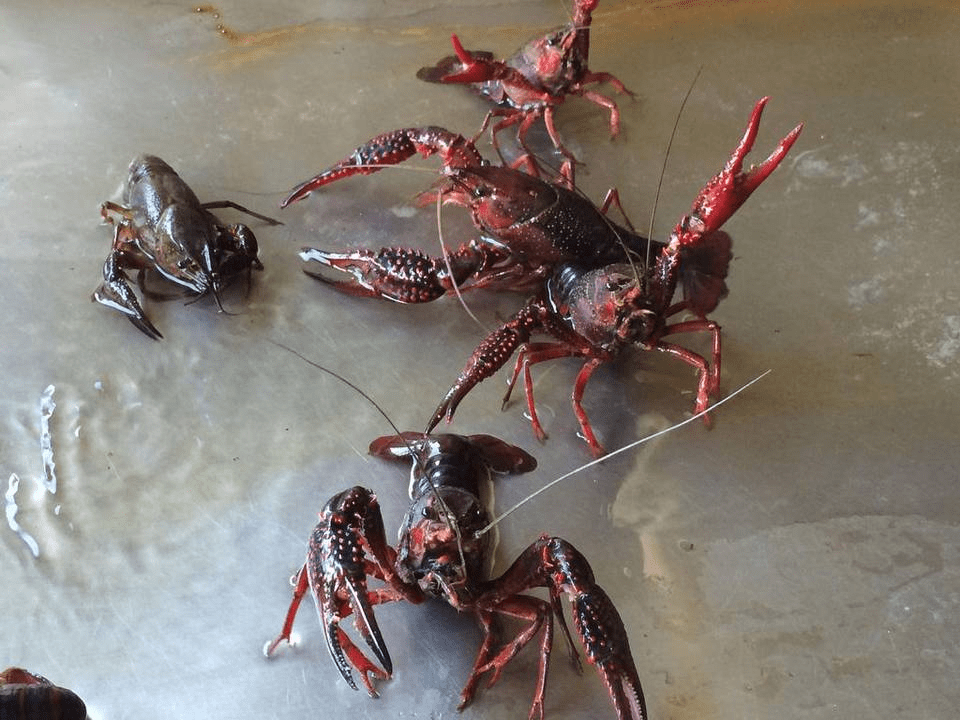Walk it like a crawfish

Walk it like a Crawfish
by Josh Jack
Louisiana loves crawfish; while we produce nearly all of the mudbugs consumed in the US — roughly 100 million pounds a year — almost 75% of those are eaten before they ever leave the state (the rest go to Texas, but also to Mississippi, Alabama, and the Florida panhandle.) We call ’em crawfish down here (or, if you’re really Cajun: ecrevisse, which is French for crawl.) Some folks call ’em crayfish — mostly people from up North where Louisiana crawfish are an invasive species. Some people call ’em crawdads, crawdaddies, or mudbugs. In Australia, which is home to almost a quarter of the planet’s crawfish species, they are called yabbies (the largest species there, the Tasmanian giant freshwater crayfish, can top out at more than ten pounds!) While there are something like 450 different species of crawfish worldwide, and 353 living in North America (the majority of them in the Southeast,) Louisiana is home to more than 30 individual species, and we mostly only eat two of them. White river crawfish (Procambarus zonangulus) constitute about 20% of what is produced, and is mostly wild-caught in freshwater rivers or large bayous. Red swamp crawfish (Procambarus clarkii) make up the further 80% and are mostly cultivated in rice fields, but can also be caught wild in the bayous and swamps.Both the white river, and the red swamp crawfish prefer to swim and crawl along the bottom and will excavate shallow burrows to lay their eggs or search for food , but other species rarely leave their burrows.
One species — the devil crawfish, or coffin-cutter crawfish — is quite common, although rarely seen. Its burrows, however, are quite conspicuous. Strange muddy chimneys, made of sun-baked balls of clay are a common sight both at the edge of wayterways and the higher land nearby. While scientist are still unsure why the crawfish build these structures, some think that they are a convenient way to use up all the backfill excavated in the process of burrowing (devil crawfish can dig burrows up to 20 feet deep; they will dig until they reach the water table) and others suspect that they have something to do with maintaining humidity and or oxygen supply (water in crawfish burrows is oxygen poor, so they must keep their gills wet in order to breath atmospheric O2; they will keep the mud/clay walls of their burrow moist, and are routinely observed plugging the holes of their chimneys during dry periods.) The tunnels beneath the smokestacks can be quite elaborate, with branching corridors and larger rooms, and the crawfish risk leaving them only to mate or search for food. Like other crawfish they prefer to gnosh on rotting plant matter, but also on worms, and fish eggs, and snails, and, while they do eat decaying animal matter as well, they are not known — as their common name implies — dig into coffins and consume the interred. People do not often eat of the devil crawfish, but wild hogs are known to gorge on them in Spring and Summer when their chimneys crowd the banks of creeks and rivers, leaving little doubt as to the abundance of little crustaceans huddled not far beneath the surface.
Those accustomed to buying crawfish by the pound or eating them by the bushel might be surprised that not everyone shares our love of mini-lobsters; indeed, in much of the world they are regarded as a pest. The red swamp crawfish, so ubiquitous in Louisiana, is an absolute barbarian abroad. They are immune to crayfish plauge, but will spread it to the native crayfish species who are not, and will additionally out-eat them, and their eggs; they are also known to breed much more quickly than the crawfish of Asian, European, Australasian, and Madagascan origin. They are consequently becoming a more and more popular food globally. While Sweden loves crawfish so much they must import 90% of what they eat (they prefer theirs rather mild by Cajun standards, but with lots of dill and butter,) China both consumes vast quantities of the invader and cultivates many more for export (they prefer to stir-fry theirs with lemongrass and ginger, and LOTS of hot chilies.) One of the more interesting food trends of recent years is Viet-Cajun style crawfish, which originated in the Vietnamese community of Houston. Viet-Cajun crawfish might be boiled after the traditional Cajun fashion, though often they are more lightly seasoned with lemongrass, and ginger, and star anise as well. However they’re boiled, they are ultimately anointed with a generous coating of garlic-butter and other spices; they are thus even messier than the standard Cajun boil, and, some would argue, more delicious.

